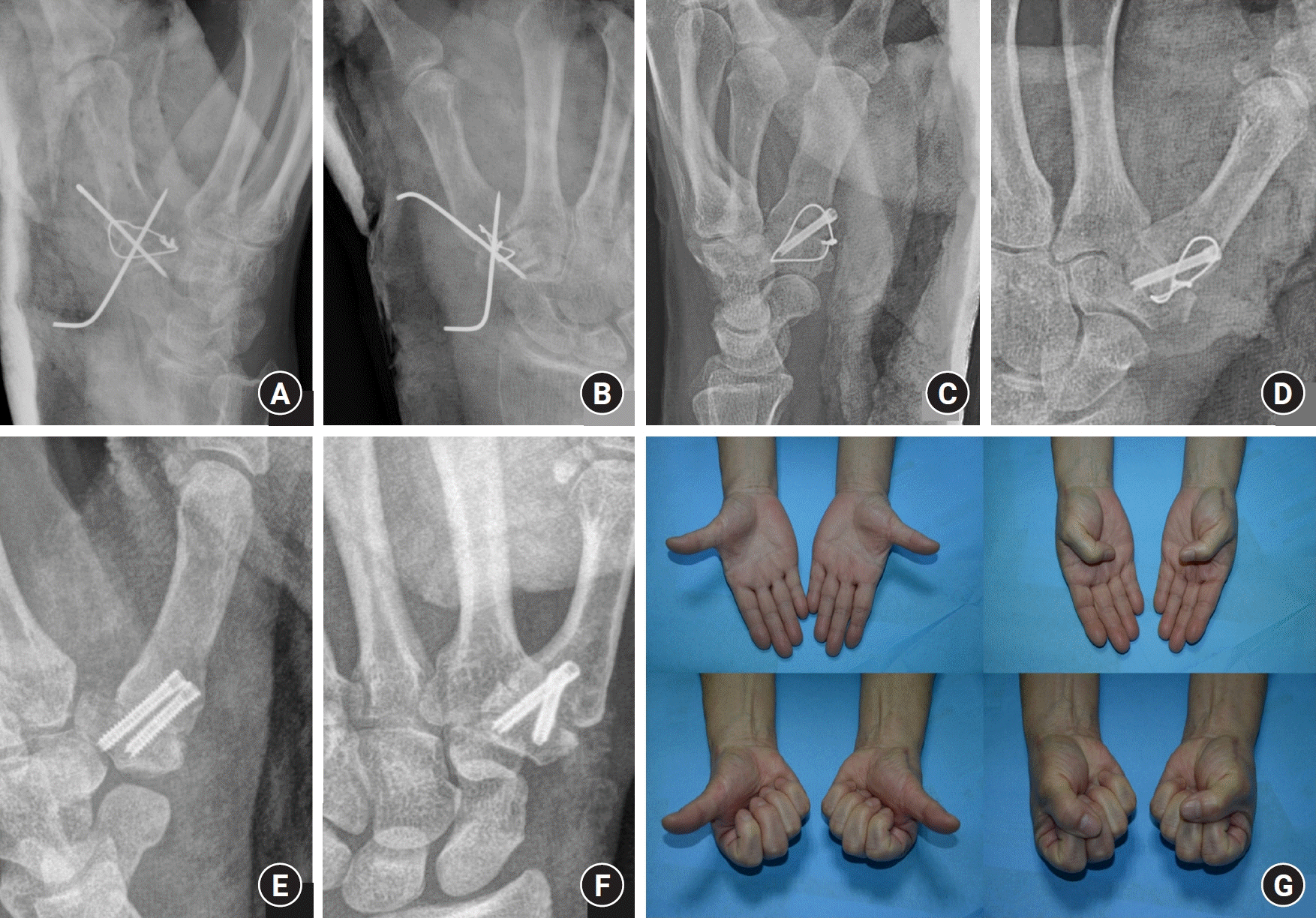1. Murray PM. Treatment of the osteoarthritic hand and thumb. In : Cohen MS, Green DP, Hotchkiss RN, Kozin SH, Pederson WC, Wolfe SW, editors. Green’s operative hand surgery. 7th ed. Philadelphia: Elsevier;2017. p. 345–72.
2. Weilby A. Surgical treatment of osteoarthritis of the carpo-metacarpal joint of the thumb: indications for arthrodesis, excision of the trapezium, and alloplasty. Scand J Plast Reconstr Surg. 1971; 5:136–41.

3. Dharamsi MS, Caudle K, Fares A, Dunn J. Arthrodesis for carpometacarpal joint arthritis: a systematic review. Hand (N Y). 2023; 18:1284–90.

4. Vermeulen GM, Slijper H, Feitz R, Hovius SE, Moojen TM, Selles RW. Surgical management of primary thumb carpometacarpal osteoarthritis: a systematic review. J Hand Surg Am. 2011; 36:157–69.

5. Wajon A, Vinycomb T, Carr E, Edmunds I, Ada L. Surgery for thumb (trapeziometacarpal joint) osteoarthritis. Cochrane Database Syst Rev. 2015; 2015:CD004631.

6. Knightly N, Sullivan P. Surgery for trapeziometacarpal joint osteoarthritis: a meta-analysis on efficacy and safety. J Hand Surg Asian Pac Vol. 2021; 26:245–64.

7. Lee JK, Yoon BH, Lee HI, Kim C, Choi S, Han SH. Prosthetic replacement has a clinical outcome superior to that of trapeziectomy with ligament reconstruction and tendon interposition: a meta-analysis. Orthopedics. 2021; 44:e151–7.

8. Yuan F, Aliu O, Chung KC, Mahmoudi E. Evidence-based practice in the surgical treatment of thumb carpometacarpal joint arthritis. J Hand Surg Am. 2017; 42:104–12.

9. Deutch Z, Niedermeier SR, Awan HM. Surgeon preference, influence, and treatment of thumb carpometacarpal arthritis. Hand (N Y). 2018; 13:403–11.

10. Kapoutsis DV, Dardas A, Day CS. Carpometacarpal and scaphotrapeziotrapezoid arthritis: arthroscopy, arthroplasty, and arthrodesis. J Hand Surg Am. 2011; 36:354–66.

11. Fulton DB, Stern PJ. Trapeziometacarpal arthrodesis in primary osteoarthritis: a minimum two-year follow-up study. J Hand Surg Am. 2001; 26:109–14.

12. Herren DB. Basal thumb arthritis surgery: complications and its management. J Hand Surg Eur Vol. 2024; 49:188–200.

13. von Elm E, Altman DG, Egger M, et al. The Strengthening the Reporting of Observational Studies in Epidemiology (STROBE) statement: guidelines for reporting observational studies. Lancet. 2007; 370:1453–7.

14. Stern PJ, Fulton DB. Distal interphalangeal joint arthrodesis: an analysis of complications. J Hand Surg Am. 1992; 17:1139–45.

15. Murray P. Treatment of the osteoarthritis hand and thumb. In : Wolfe SW, Pederson WC, Hotchkiss RN, Kozin SH, Cohen MS, editors. Green’s operative hand surgery. 7th ed. Philadelphia: Elsevier Health Sciences;2016. p. 345–72.
16. Russo S, Bernasconi A, Busco G, Sadile F. Treatment of the trapeziometacarpal osteoarthritis by arthroplasty with a pyrocarbon implant. Int Orthop. 2016; 40:1465–71.

17. Rizzo M, Moran SL, Shin AY. Long-term outcomes of trapeziometacarpal arthrodesis in the management of trapeziometacarpal arthritis. J Hand Surg Am. 2009; 34:20–6.

18. Vermeulen GM, Brink SM, Slijper H, et al. Trapeziometacarpal arthrodesis or trapeziectomy with ligament reconstruction in primary trapeziometacarpal osteoarthritis: a randomized controlled trial. J Bone Joint Surg Am. 2014; 96:726–33.
19. Spekreijse KR, Selles RW, Kedilioglu MA, et al. Trapeziometacarpal arthrodesis or trapeziectomy with ligament reconstruction in primary trapeziometacarpal osteoarthritis: a 5-year follow-up. J Hand Surg Am. 2016; 41:910–6.
20. Tang JB. Re: Levels of experience of surgeons in clinical studies. J Hand Surg Eur Vol. 2009; 34:137–8.

21. Rubino M, Civani A, Pagani D, Sansone V. Trapeziometacarpal narrow pseudarthrosis: a new surgical technique to treat thumb carpometacarpal joint arthritis. J Hand Surg Eur Vol. 2013; 38:844–50.

22. Goldfarb CA, Stern PJ. Indications and techniques for thumb carpometacarpal arthrodesis. Tech Hand Up Extrem Surg. 2002; 6:178–84.

23. Galán A, Arenas JR, del Águila B, Guerado E, Andrés-Cano P. Trapezio-metacarpal arthrodesis: procedure and results. Eur J Orthop Surg Traumatol. 2015; 25:483–8.

24. Zhang X, Wang T, Wan S. Minimally invasive thumb carpometacarpal joint arthrodesis with headless screws and arthroscopic assistance. J Hand Surg Am. 2015; 40:152–8.
25. Sehjal R, Rusli W, Kedgley AE, Sagmeister ML, Williamson M, Smith A. Biomechanical comparison of 5 different fixation constructs in a trapeziometacarpal joint arthrodesis model. J Hand Surg Am. 2023; Feb. 9. [Epub].
https://doi.org/10.1016/j.jhsa.2022.12.010.

26. Stokel EA, Tencer AF, Driscoll HL, Trumble TE. A biomechanical comparison of four methods of fixation of the trapeziometacarpal joint. J Hand Surg Am. 1994; 19:86–92.

27. Berger AJ, Meals RA. Management of osteoarthrosis of the thumb joints. J Hand Surg Am. 2015; 40:843–50.









 PDF
PDF Citation
Citation Print
Print



 XML Download
XML Download